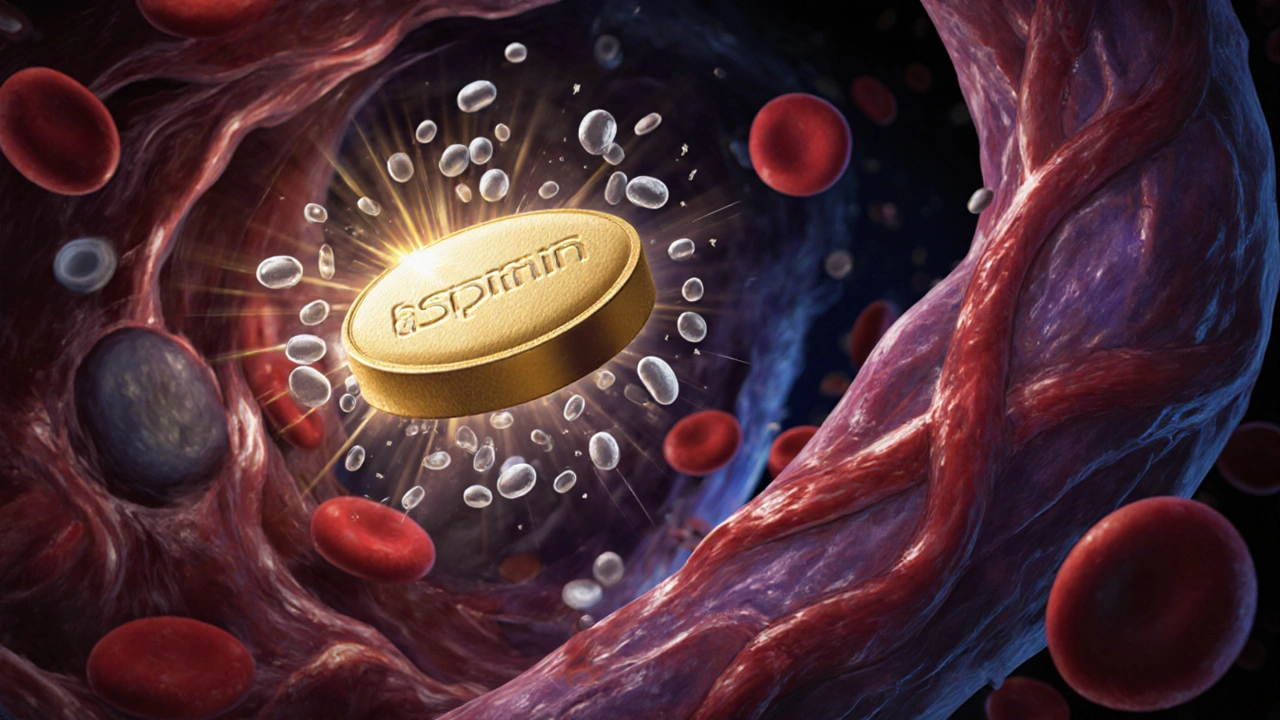DVT Risk Assessment Tool
How to Use This Tool
This tool estimates your risk of developing deep vein thrombosis (DVT) based on medical factors. Remember: Aspirin does not treat varicose veins, but may help prevent clots in high-risk individuals. Always consult your doctor before starting any medication.
Your Risk Factors
Quick Takeaways
- Varicose veins are swollen, twisted veins caused by weak vein walls and faulty valves.
- aspirin reduces platelet aggregation but does not shrink existing varicose veins.
- Evidence links low‑dose aspirin to a modest drop in deep‑vein clot risk for high‑risk patients.
- Standard varicose‑vein care focuses on compression, lifestyle changes, and minimally invasive procedures.
- Talk to a doctor before adding aspirin, especially if you take blood‑thinners or have ulcer ulcers.
What Are Varicose Veins?
Varicose veins are enlarged, twisted superficial veins that usually appear on the legs and ankles. They develop when vein walls become weak and one‑way valves fail, causing blood to pool and the vessels to bulge. The condition affects up to 30% of adults, with women and people who stand for long periods at higher risk.
Key factors that worsen the problem include genetics, obesity, pregnancy, hormonal changes, and prolonged sitting or standing. When the venous system can’t push blood efficiently back to the heart, the pressure builds up, leading to the characteristic blue‑purple cords.
Most people notice aching, heaviness, or itching, especially after a day on their feet. In severe cases, skin discoloration, ulceration, or blood‑clot formation can occur.
How Aspirin Works in the Body
Aspirin is a classic nonsteroidal anti‑inflammatory drug (NSAID) that blocks the enzyme cyclo‑oxygenase (COX), reducing the production of prostaglandins. This action eases pain, lowers fever, and - crucially for veins - inhibits platelet aggregation, the process by which blood cells clump together to form clots.
Platelet aggregation is essential for stopping bleeding, but excess clotting in the deep veins can trigger a deep‑vein thrombosis (DVT). By dampening this activity, low‑dose aspirin is sometimes prescribed to lower the risk of DVT in people with a history of clotting disorders.
Because aspirin’s primary benefit is anti‑platelet, it does not directly affect the structural integrity of vein walls or the valve function that drives varicose‑vein formation.

Does Aspirin Treat Varicose Veins?
Clinical research on aspirin as a standalone varicose‑vein therapy is sparse. Most studies focus on its role in preventing venous thromboembolism rather than shrinking existing veins.
A 2021 observational study of 4,200 patients with chronic venous insufficiency found that low‑dose aspirin (75mg daily) lowered the incidence of new DVT events by 12% but did not change the size or symptoms of existing varicose veins. Another small trial in 2019 reported modest improvement in leg pain when aspirin was combined with compression stockings, but the effect disappeared after the medication stopped.
Overall, the evidence suggests aspirin may help prevent complications (like clots) in people who already have venous disease, but it does not replace targeted vein treatments for cosmetic or symptomatic relief.
Potential Benefits and Risks of Using Aspirin for Vein Health
- Benefits
- Reduced risk of DVT in high‑risk groups (e.g., those with a prior clot or major surgery).
- Possible mild relief of leg discomfort when paired with compression therapy.
- Low cost and easy oral administration.
- Risks
- Increased bleeding tendency, especially in the gastrointestinal tract.
- Potential interaction with other blood‑thinners, anticoagulants, or certain antihypertensive drugs.
- Kidney irritation in people with chronic kidney disease.
Because aspirin’s anti‑platelet effect is systemic, anyone with a history of ulcers, recent surgery, or uncontrolled hypertension should discuss alternatives with a healthcare professional.
Standard Treatments for Varicose Veins
Most clinicians recommend a tiered approach, starting with conservative measures and moving to minimally invasive procedures if symptoms persist.
| Method | How It Works | Typical Success Rate | Main Risks | Relative Cost |
|---|---|---|---|---|
| Aspirin | Inhibits platelet aggregation, lowers clot risk | ~0% for vein removal; modest pain relief when combined with compressions | Bleeding, gastrointestinal upset | Very low |
| Compression Stockings | Applies graded pressure to improve venous return | 30‑50% symptom improvement | Discomfort, skin irritation | Low |
| Sclerotherapy | Injects a sclerosant to collapse small veins | 70‑90% for spider veins, 50‑70% for larger veins | Bruising, hyperpigmentation | Moderate |
| Endovenous Laser Therapy (EVLT) | Laser fiber heats and closes the faulty vein | 90‑95% long‑term closure | Minor nerve injury, temporary pain | High |
| Vein Stripping Surgery | Physical removal of the diseased vein | 95‑98% removal success | Scarring, infection, longer recovery | Very high |
Most patients start with compression stockings and lifestyle tweaks. If those don’t alleviate pain or cosmetic concerns, a doctor may recommend sclerotherapy for smaller veins or EVLT for larger tributaries.
When Aspirin Might Be Considered
If you have varicose veins *and* an additional risk factor for clot formation (recent orthopedic surgery, known thrombophilia, or prolonged immobilisation), a clinician might prescribe low‑dose aspirin as a preventive measure. In that scenario, aspirin works alongside the primary vein treatment, not as a cure for the varicose veins themselves.
Key situations where aspirin is commonly discussed:
- History of DVT or pulmonary embolism.
- Upcoming major surgery where clot risk spikes.
- Concurrent cardiovascular disease requiring antiplatelet therapy.
Even in these cases, doctors balance the clot‑prevention benefit against bleeding risk, especially for older adults on other medications.
Lifestyle Tips and Self‑Care Strategies
Beyond medication, everyday habits can slow vein deterioration:
- Wear Compression Stockings during long flights or standing shifts.
- Move every 30minutes - ankle pumps, calf raises, or a short walk.
- Maintain a healthy weight; excess mass strains leg veins.
- Elevate legs above heart level for 10‑15minutes after long standing periods.
- Choose low‑impact exercise (swimming, cycling) to boost circulation without over‑loading the legs.
These measures reduce venous pressure and often make other treatments more effective.
Frequently Asked Questions
Can aspirin shrink existing varicose veins?
No. Aspirin’s anti‑platelet action helps prevent clot formation but does not improve vein wall strength or valve function, so it won’t make the veins disappear.
Is low‑dose aspirin safe for everyone with varicose veins?
It’s safe for many people, but those with a history of stomach ulcers, bleeding disorders, or who take other blood‑thinners should consult a doctor before starting.
How long should I take aspirin if my doctor prescribes it?
Typical regimens are 75‑81mg daily for 6‑12months, depending on your clot‑risk profile. Always follow the prescribing physician’s timeline.
Do compression stockings work without medication?
Yes. For many mild to moderate cases, graduated compression alone relieves heaviness, reduces swelling, and can delay disease progression.
What are the signs that varicose veins have become dangerous?
Sudden pain, redness, warmth, swelling, or a fever may signal a clot or infection. Skin ulceration, bleeding, or a feeling of heaviness that worsens at night also warrants medical attention.

Matthew Platts
July 16, 2025 AT 19:24Great to see a tool that reminds us aspirin isn’t a magic fix for varicose veins but can still play a role in clot prevention. Keep sharing these practical health checks!
Kasey Mynatt
July 19, 2025 AT 10:24Indeed, while aspirin won’t shrink those bulging veins, its antiplatelet effect may reduce the likelihood of a deep‑vein thrombosis in high‑risk patients. Always pair it with physician guidance.
Edwin Pennock
July 22, 2025 AT 01:24People act like aspirin is some universal cure, but the evidence for its impact on varicose veins is practically nonexistent.
John McGuire
July 24, 2025 AT 16:24Exactly! 😎 The tool is a reminder to look at the bigger picture-lifestyle, compression stockings, and proper medical advice matter more than a pill.
newsscribbles kunle
July 27, 2025 AT 07:24Frankly, the real problem is that many ignore basic health responsibilities in favor of quick fixes; we need to prioritize disciplined living over pop‑science shortcuts.
Bernard Williams
July 29, 2025 AT 22:24Aspirin’s primary mechanism is inhibition of the cyclooxygenase‑1 enzyme, which reduces thromboxane A2 and thereby limits platelet aggregation.
When it comes to varicose veins, the pathology is largely related to venous valve insufficiency and chronic venous hypertension, not platelet clotting.
Therefore, aspirin does not address the underlying cause of varicose veins and cannot reverse their appearance.
However, patients with varicose veins who also possess additional thrombotic risk factors-such as prolonged immobility, recent surgery, or a personal history of DVT-may benefit from its antithrombotic properties.
In those high‑risk scenarios, low‑dose aspirin can serve as a prophylactic measure against deep‑vein thrombosis.
Clinical guidelines generally recommend aspirin for primary prevention only in specific populations, and its use should be individualized.
It is essential to consider bleeding risk, especially in patients with gastrointestinal ulcers or concomitant anticoagulant therapy.
For most individuals with uncomplicated varicose veins, compression therapy, leg elevation, and regular exercise remain the cornerstone of management.
Surgical options, such as sclerotherapy or endovenous laser ablation, directly target the faulty veins and provide symptomatic relief.
When evaluating a patient, a thorough history should assess age, comorbidities, medication profile, and lifestyle factors.
Laboratory tests might be warranted to rule out hypercoagulable states if there is a strong family history of clotting disorders.
Physicians should discuss the limited role of aspirin in vein disease and emphasize evidence‑based interventions.
Patients should never self‑prescribe aspirin for varicose veins without consulting a healthcare professional.
In summary, aspirin is not a treatment for varicose veins themselves but may have a supportive role in preventing clot formation in selected high‑risk individuals.
Michelle Morrison
August 1, 2025 AT 13:24In summation, aspirin’s utility remains circumscribed to thromboprophylaxis rather than venous insufficiency.
harold dixon
August 4, 2025 AT 04:24While Bernard’s overview is thorough, remember that individual risk factors like prolonged immobility can outweigh generic advice; personalized assessment is key.
Darrin Taylor
August 6, 2025 AT 19:24Honestly, the whole DVT calculator feels like a marketing gimmick to sell aspirin coupons.
Anthony MEMENTO
August 9, 2025 AT 10:24One could argue that the calculator oversimplifies complex hemodynamics, yet it still offers a useful baseline for patient–doctor discussions.
aishwarya venu
August 12, 2025 AT 01:24I love that this tool encourages us to think proactively about clot risk-stay safe and stay informed!
Nicole Koshen
August 14, 2025 AT 16:24Just a note: the phrase “high‑risk individuals” should be hyphenated, and “aspirin does not treat varicose veins” needs a comma after “veins” for clarity.
Ed Norton
August 17, 2025 AT 07:24Thanks for the heads‑up, everyone. Good stuff.
Karen Misakyan
August 19, 2025 AT 22:24From an epistemological standpoint, the reliance on algorithmic risk stratification reflects a broader shift toward quantifiable medicine, wherein subjective clinical judgment is increasingly supplemented by computational models.
Amy Robbins
August 22, 2025 AT 13:24Oh sure, just pop a couple of pills and your varicose veins will vanish-what could possibly go wrong?
Shriniwas Kumar
August 25, 2025 AT 04:24In the context of venous hemodynamics, antiplatelet therapy modulates platelet aggregation pathways, thereby attenuating thrombin generation and subsequent fibrin clot formation, which is particularly pertinent in stasis‑prone vascular territories.
Sudha Srinivasan
August 27, 2025 AT 19:24dont forget to move around alot